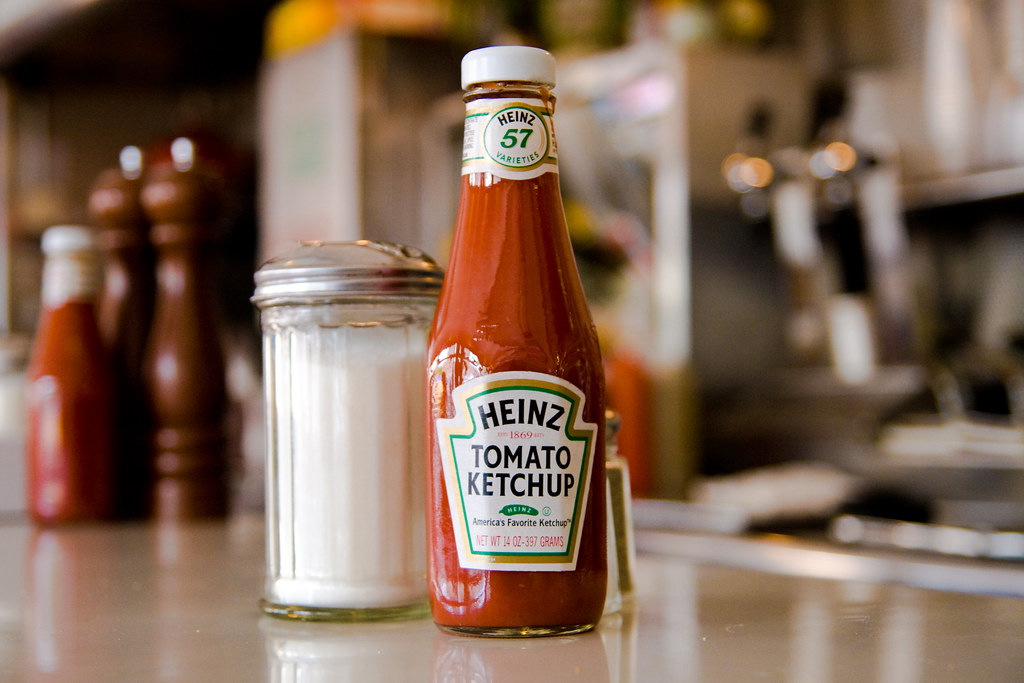The Surprising History Of America’s Most Beloved Condiment
As I was watching the old 1940’s Julie Garland movie, Meet Me in St. Louis for the first time, there is a charming part in the beginning where the cook is making a big pot of ketchup that they will pour into jars and store. They are all taste testing it and saying it is too sweet or “needs more salt!”. This movie takes place in the early 1900’s and really got me thinking about the history of ketchup and how long it has really been around. It goes WAY, way back and starts out as something in Imperial China that you would never dream as being the original form of the condiment that 97 percent of kitchens in the United States have.

The Origins of Ketchup
In the 1690’s the Chinese mixed a concoction of pickled fish and spices and called it (in the Amoy dialect) koe-chiap, or ke-chiap, which means the brine of a pickled fish. That’s right--ketchup actually started more as a fish sauce and didn’t turn into the tomato-based sauce we know and love until 1812! The old, original fish ketchup was used more in dishes as opposed to a sauce to be used on the side. It was a salty, fermented fish paste that was easily stored for long distances and was often brought on long ocean voyages.

The paste made its way to trade routes to Indonesia and the Philippines, where British traders developed a taste for it. They took samples back home and proceeded to corrupt it to the point where it was completely unrecognizable compared to what it started as. They decided to use tomatoes and plenty of other foods you would never think of, instead of fish.
Quick tomato fun fact!
Tomatoes were brought to Europe in the 1500s from South America but it took a couple centuries before people started eating them regularly, as they were thought to be poisonous. They thought this because wealthy Englishmen ate tomato based dishes from lead pewter plates and the acid from the tomatoes would react and leach the lead into the food, causing food poisoning. Hence the reason that people thought tomatoes were poisonous!
The 18th Century and ALL of the ketchups!
The 18th Century is really when ketchup got wild. Cookbooks feature recipes for all sorts of different ketchups made from things like oysters, mussels, mushrooms, walnuts, lemons, celery and even fruits like plums and peaches. They would cook them all the way down until they were a syrup-like consistency and leave them to sit with salt for extended periods of time. The result was a highly concentrated salty, spicy paste that could last for a long time without going bad. Now, it seems we are getting a little closer to the ketchup we know and love today.
Modern Ketchup is Born
The first recipe for ketchup as we know it today is from a Philadelphian scientist named James Mease in 1812. Before vinegar was the standard ingredient to preserve the tomato-based sauce, the sauce would go rancid quickly as the fruit would break down. In 1876, a relatively new company called Heinz introduced their famous formulation which contained vinegar, brown sugar, salt and various spices. They were also the first ones to introduce glass bottles so that customers could see what they were getting. Tomato ketchup slowly but surely became the American staple condiment it is today and Heinz is the best-selling brand of ketchup, selling more than 650 million bottles each year. (My very favorite store bought ketchup is actually the organic ketchup from Trader Joe’s. It is such a wonderful blend of spices and it makes everything taste better.)

Well, next time you pull out your bottle of ketchup to dip your fries in, you might remember how far this beloved condiment has come to be what it is now. I think it is pretty hard for most Americans to think of it any other way than the brightly colored red tomato sauce we think of now.
One last question for you--this is a pretty polarizing one, so be prepared! Do you like to dip your grilled cheese sandwiches in ketchup? I grew up doing this and my kids love to dip theirs in ketchup, but my husband thinks it’s very weird :) What team are you on? And is there anything you dip in ketchup that most people would think is strange? Please share your thoughts in the comments below. For fun I thought I’d post a recipe for ketchup from 1861 where you’d make a big batch, pour it into bottles, top it with a cotton cloth tied loosely shut, and leave it out to ferment for 3 months. Yum! :/
Tomato Catsup (from the Housekeeper’s Encyclopedia by Mrs. E.F. Haskell, 1861)
1 gallon tomatoes
3 Tbs. salt
3 Tbs. ground black pepper
3 Tbs. (dry) mustard, or ground mustard seed
1 tsp. ground allspice
4 peppers, type unspecified but “sweet”, not hot
1 onion (optional)
1 quart horseradish “juice” (roots grated and liquid pressed out)
Select tomatoes that are not overripe, skin and strain the tomatoes; to every gallon add three tablespoons of salt, three of ground black pepper, three of mustard, and one teaspoon of ground allspice; mix the spices in a part of the tomato, and strain them through a sieve; put in a small bag four large pods of sweet peppers and, if relished, one onion, and boil them with the catsup while it is being reduced; add the expressed juice of one quart of horseradish, and reduce it until it is of the proper consistency to pour from the bottles without difficulty; let the catsup remain in the bottles, with a piece of cotton cloth tied loosely on the neck, for three months to ripen, then cork and seal tightly.
Note from Mary: I typed up an old recipe at the bottom of this article, but it's more just for reference for a cool old recipe--not really one that people would actually cook up, so that is why I didn't create a DVO recipe for it.

The Origins of Ketchup
In the 1690’s the Chinese mixed a concoction of pickled fish and spices and called it (in the Amoy dialect) koe-chiap, or ke-chiap, which means the brine of a pickled fish. That’s right--ketchup actually started more as a fish sauce and didn’t turn into the tomato-based sauce we know and love until 1812! The old, original fish ketchup was used more in dishes as opposed to a sauce to be used on the side. It was a salty, fermented fish paste that was easily stored for long distances and was often brought on long ocean voyages.

The paste made its way to trade routes to Indonesia and the Philippines, where British traders developed a taste for it. They took samples back home and proceeded to corrupt it to the point where it was completely unrecognizable compared to what it started as. They decided to use tomatoes and plenty of other foods you would never think of, instead of fish.
Quick tomato fun fact!
Tomatoes were brought to Europe in the 1500s from South America but it took a couple centuries before people started eating them regularly, as they were thought to be poisonous. They thought this because wealthy Englishmen ate tomato based dishes from lead pewter plates and the acid from the tomatoes would react and leach the lead into the food, causing food poisoning. Hence the reason that people thought tomatoes were poisonous!
The 18th Century and ALL of the ketchups!
The 18th Century is really when ketchup got wild. Cookbooks feature recipes for all sorts of different ketchups made from things like oysters, mussels, mushrooms, walnuts, lemons, celery and even fruits like plums and peaches. They would cook them all the way down until they were a syrup-like consistency and leave them to sit with salt for extended periods of time. The result was a highly concentrated salty, spicy paste that could last for a long time without going bad. Now, it seems we are getting a little closer to the ketchup we know and love today.
Modern Ketchup is Born
The first recipe for ketchup as we know it today is from a Philadelphian scientist named James Mease in 1812. Before vinegar was the standard ingredient to preserve the tomato-based sauce, the sauce would go rancid quickly as the fruit would break down. In 1876, a relatively new company called Heinz introduced their famous formulation which contained vinegar, brown sugar, salt and various spices. They were also the first ones to introduce glass bottles so that customers could see what they were getting. Tomato ketchup slowly but surely became the American staple condiment it is today and Heinz is the best-selling brand of ketchup, selling more than 650 million bottles each year. (My very favorite store bought ketchup is actually the organic ketchup from Trader Joe’s. It is such a wonderful blend of spices and it makes everything taste better.)

Well, next time you pull out your bottle of ketchup to dip your fries in, you might remember how far this beloved condiment has come to be what it is now. I think it is pretty hard for most Americans to think of it any other way than the brightly colored red tomato sauce we think of now.
One last question for you--this is a pretty polarizing one, so be prepared! Do you like to dip your grilled cheese sandwiches in ketchup? I grew up doing this and my kids love to dip theirs in ketchup, but my husband thinks it’s very weird :) What team are you on? And is there anything you dip in ketchup that most people would think is strange? Please share your thoughts in the comments below. For fun I thought I’d post a recipe for ketchup from 1861 where you’d make a big batch, pour it into bottles, top it with a cotton cloth tied loosely shut, and leave it out to ferment for 3 months. Yum! :/
Tomato Catsup (from the Housekeeper’s Encyclopedia by Mrs. E.F. Haskell, 1861)
1 gallon tomatoes
3 Tbs. salt
3 Tbs. ground black pepper
3 Tbs. (dry) mustard, or ground mustard seed
1 tsp. ground allspice
4 peppers, type unspecified but “sweet”, not hot
1 onion (optional)
1 quart horseradish “juice” (roots grated and liquid pressed out)
Select tomatoes that are not overripe, skin and strain the tomatoes; to every gallon add three tablespoons of salt, three of ground black pepper, three of mustard, and one teaspoon of ground allspice; mix the spices in a part of the tomato, and strain them through a sieve; put in a small bag four large pods of sweet peppers and, if relished, one onion, and boil them with the catsup while it is being reduced; add the expressed juice of one quart of horseradish, and reduce it until it is of the proper consistency to pour from the bottles without difficulty; let the catsup remain in the bottles, with a piece of cotton cloth tied loosely on the neck, for three months to ripen, then cork and seal tightly.
Note from Mary: I typed up an old recipe at the bottom of this article, but it's more just for reference for a cool old recipe--not really one that people would actually cook up, so that is why I didn't create a DVO recipe for it.
Sources:
blog comments powered by Disqus
- www.flickr.com
- www.pxfuel.com
- www.history.com
- www.maxpixel.net
- www.ordinary-times.com
 Mary Richardson
Mary Richardson
Weekly Newsletter Contributor since 2014
Email the author! mary@dvo.com
